Effect of 3D Printing Process Parameters on Damping Characteristic of Cantilever Beams Fabricated Using Material Extrusion
Abstract
:1. Introduction
2. Methodology
2.1. Identification of Damping Properties
2.2. Specimen Fabrication
2.3. Design of Experiment
2.3.1. Process Parameter Determination
2.3.2. Experimental Setup and Procedures
2.4. Experimental Data Post-Process and Analysis
2.4.1. Damping Ratio Calculation
2.4.2. Statistical Analysis
3. Results and Discussion
3.1. Effect of Process Parameters on Modal Damping Ratios
3.2. Effect of Process Parameters on Loss Factor
3.3. Regression Model Development
3.4. The Theoretical Justification for Process Parameter Influence on Damping Behaviour
3.5. Comparison with the Previous Related Studies
4. Conclusions
Author Contributions
Funding
Institutional Review Board Statement
Informed Consent Statement
Data Availability Statement
Conflicts of Interest
References
- Joshi, S.C.; Sheikh, A.A. 3D printing in aerospace and its long-term sustainability. Virtual Phys. Prototyp. 2015, 10, 175–185. [Google Scholar] [CrossRef]
- Aimar, A.; Palermo, A.; Innocenti, B. The role of 3D printing in medical applications: A state of the art. J. Healthc. Eng. 2019, 2019, 1–10. [Google Scholar] [CrossRef] [PubMed] [Green Version]
- Gao, H.; Zhang, W.; Yu, Z.; Xin, F.; Jiang, M. Emerging applications of 3D printing in biomanufacturing. Trends Biotechnol. 2021, 39, 1114–1116. [Google Scholar] [CrossRef] [PubMed]
- ISO/TC 261; Additive manufacturing ISO/ASTM 52900:2021 (En), Additive Manufacturing—General Principles—Fundamentals and Vocabulary. ISO: Geneva, Switzerland, 2021.
- Shanmugam, V.; Das, O.; Babu, K.; Marimuthu, U.; Veerasimman, A.; Johnson, D.J.; Neisiany, R.E.; Hedenqvist, M.S.; Ramakrishna, S.; Berto, F. Fatigue behaviour of FDM-3D printed polymers, polymeric composites and architected cellular materials. Int. J. Fatigue 2021, 143, 106007. [Google Scholar] [CrossRef]
- Popescu, D.; Zapciu, A.; Amza, C.; Baciu, F.; Marinescu, R. FDM process parameters influence over the mechanical properties of polymer specimens: A review. Polym. Test 2018, 69, 157–166. [Google Scholar] [CrossRef]
- Gordelier, T.J.; Thies, P.R.; Turner, L.; Johanning, L. Optimising the FDM additive manufacturing process to achieve maximum tensile strength: A state-of-the-art review. Rapid Prototyp. J. 2019, 25, 953–971. [Google Scholar] [CrossRef]
- Mwema, F.M.; Akinlabi, E.T. Basics of fused deposition modelling (FDM). In Fused Deposition Modeling; Springer: Cham, Switzerland, 2020; pp. 1–15. [Google Scholar]
- Bárnik, F.; Vaško, M.; Sága, M.; Handrik, M.; Sapietová, A. Mechanical properties of structures produced by 3D printing from composite materials. MATEC Web Conf. 2019, 254, 01018. [Google Scholar] [CrossRef]
- Wang, P.; Zou, B.; Ding, S.; Li, L.; Huang, C. Effects of FDM-3D printing parameters on mechanical properties and microstructure of CF/PEEK and GF/PEEK. Chin. J. Aeronaut. 2021, 34, 236–246. [Google Scholar] [CrossRef]
- Camargo, J.C.; Machado, Á.R.; Almeida, E.C.; Silva, E.F.M.S. Mechanical properties of PLA-graphene filament for FDM 3D printing. Int. J. Adv. Manuf. Technol. 2019, 103, 2423–2443. [Google Scholar] [CrossRef]
- Fernandes, J.; Deus, A.M.; Reis, L.; Vaz, M.F.; Leite, M. Study of the influence of 3D printing parameters on the mechanical properties of PLA. In Proceedings of the International Conference on Progress in Additive Manufacturing, Singapore, 14–17 May 2018; Volume 2018. [Google Scholar]
- Lee, D.; Wu, G.Y. Parameters affecting the mechanical properties of three-dimensional (3D) printed carbon fiber-reinforced polylactide composites. Polymers 2020, 12, 2456. [Google Scholar] [CrossRef]
- Saenz, F.; Otarola, C.; Valladares, K.; Rojas, J. Influence of 3D printing settings on mechanical properties of ABS at room temperature and 77 K. Addit. Manuf. 2021, 39, 101841. [Google Scholar] [CrossRef]
- Paggi, R.A.; Salmoria, G.V.; Ghizoni, G.B.; de Medeiros Back, H.; de Mello Gindri, I. Structure and mechanical properties of 3D-printed cellulose tablets by fused deposition modeling. Int. J. Adv. Manuf. Technol. 2019, 100, 2767–2774. [Google Scholar] [CrossRef]
- Zakaria, H.; Khan, S.F.; Sabtu, S.N.; Ibrahim, M. Mechanical properties of commercial PLA filament as 3D printed parts utilising fused filament fabrication. In Proceedings of the IOP Conference Series: Materials Science and Engineering, Hiroshima, Japan, 26–28 March 2019; Volume 670. [Google Scholar]
- Gómez-Gras, G.; Abad, M.D.; Pérez, M.A. Mechanical performance of 3D-Printed biocompatible polycarbonate for biomechanical applications. Polymers 2021, 13, 3669. [Google Scholar] [CrossRef]
- Jayakumar, N.; Senthilkumar, G.; Pradeep, A.D. Effect of printing parameters of 3D printed PLA parts on mechanical properties. J. Eng. Res. 2021, 9. [Google Scholar] [CrossRef]
- Sanei, S.H.R.; Popescu, D. 3d-printed carbon fiber reinforced polymer composites: A systematic review. J. Compos. Sci. 2020, 4, 98. [Google Scholar] [CrossRef]
- EL MAGRI, A.; VANAEI, S.; SHIRINBAYAN, M.; Vaudreuil, S.; TCHARKHTCHI, A. An Investigation to Study the Effect of Process Parameters on the Strength and Fatigue Behavior of 3D-Printed PLA-Graphene. Polymers 2021, 13, 3218. [Google Scholar] [CrossRef]
- Safai, L.; Cuellar, J.S.; Smit, G.; Zadpoor, A.A. A review of the fatigue behavior of 3D printed polymers. Addit. Manuf. 2019, 28, 87–97. [Google Scholar] [CrossRef]
- Azadi, M.; Dadashi, A.; Dezianian, S.; Kianifar, M.; Torkaman, S.; Chiyani, M. High-cycle bending fatigue properties of additive-manufactured ABS and PLA polymers fabricated by fused deposition modeling 3D-printing. Forces Mech. 2021, 3, 100016. [Google Scholar] [CrossRef]
- Azadi, M.; Dadashi, A. Experimental fatigue dataset for additive-manufactured 3D-Printed polylactic acid biomaterials under fully-reversed rotating-bending bending loadings. Data Brief 2022, 41, 107846. [Google Scholar] [CrossRef]
- Jerez-Mesa, R.; Travieso-Rodriguez, J.A.; Llumà-Fuentes, J.; Gomez-Gras, G.; Puig, D. Fatigue lifespan study of PLA parts obtained by additive manufacturing. Procedia Manuf. 2017, 13, 872–887. [Google Scholar] [CrossRef]
- Domingo-Espin, M.; Travieso-Rodriguez, J.A.; Jerez-Mesa, R.; Lluma-Fuentes, J. Fatigue performance of ABS specimens obtained by fused filament fabrication. Materials 2018, 10, 2521. [Google Scholar] [CrossRef] [PubMed] [Green Version]
- Padzi, M.M.; Bazin, M.M.; Muhamad, W.M.W. Fatigue characteristics of 3D printed acrylonitrile butadiene styrene (ABS). In Proceedings of the IOP Conference Series: Materials Science and Engineering, Tianjin, China, 22–24 September 2017; Volume 269. [Google Scholar]
- Travieso-Rodriguez, J.A.; Jerez-Mesa, R.; Llumà, J.; Traver-Ramos, O.; Gomez-Gras, G.; Rovira, J.J.R. Mechanical properties of 3D-printing polylactic acid parts subjected to bending stress and fatigue testing. Materials 2019, 12, 3859. [Google Scholar] [CrossRef] [PubMed] [Green Version]
- Gomez-Gras, G.; Jerez-Mesa, R.; Travieso-Rodriguez, J.A.; Lluma-Fuentes, J. Fatigue performance of fused filament fabrication PLA specimens. Mater. Des. 2018, 140, 278–285. [Google Scholar] [CrossRef] [Green Version]
- Ge, C.; Cormier, D.; Rice, B. Damping and cushioning characteristics of polyjet 3D printed photopolymer with kelvin model. J. Cell. Plast. 2021, 57, 517–534. [Google Scholar] [CrossRef]
- Zhang, M.; Yu, Q.; Liu, Z.; Zhang, J.; Tan, G.; Jiao, D.; Zhu, W.; Li, S.; Zhang, Z.; Yang, R.; et al. 3D printed Mg-NiTi interpenetrating-phase composites with high strength, damping capacity, and energy absorption efficiency. Sci. Adv. 2020, 6, eaba5581. [Google Scholar] [CrossRef] [PubMed]
- Wang, R.; Shang, J.; Li, X.; Luo, Z.; Wu, W. Vibration and damping characteristics of 3D printed kagome lattice with viscoelastic material filling. Sci. Rep. 2018, 8, 1–13. [Google Scholar] [CrossRef] [PubMed] [Green Version]
- León-Calero, M.; Reyburn Valés, S.C.; Marcos-Fernández, Á.; Rodríguez-Hernandez, J. 3D printing of thermoplastic elastomers: Role of the chemical composition and printing parameters in the production of parts with controlled energy absorption and damping capacity. Polymers 2021, 13, 3551. [Google Scholar] [CrossRef]
- Medel, F.; Abad, J.; Esteban, V. Stiffness and damping behavior of 3D printed specimens. Polym. Test. 2022, 109, 107529. [Google Scholar] [CrossRef]
- Rao, S.S. Vibration of Continuous Systems; John Wiley & Sons: Hoboken, NJ, USA, 2019. [Google Scholar]
- Xu, Z.; Ma, L. Structural Dynamics; Anqi, T., Ed.; Version 1; Science Press: Beijing, China, 2007; ISBN 978-7-03-020457-8. [Google Scholar]
- Rao, S.S.; Griffin, P. Mechanical Vibrations Fifth Edition in SI Units. In Mechanical Vibrations; Pearson: London, UK, 2011. [Google Scholar]
- He, F.; Khan, M. Effects of printing parameters on the fatigue behaviour of 3D-printed ABS under dynamic thermo-mechanical loads. Polymers 2021, 13, 2362. [Google Scholar] [CrossRef]
- Alshammari, Y.L.A.; He, F.; Khan, M.A. Modelling and investigation of crack growth for 3D-Printed acrylonitrile butadiene styrene (ABS) with various printing parameters and ambient temperatures. Polymers 2021, 13, 3737. [Google Scholar] [CrossRef]
- Baqasah, H.; He, F.; Zai, B.A.; Asif, M.; Khan, K.A.; Thakur, V.K.; Khan, M.A. In-situ dynamic response measurement for damage quantification of 3D printed ABS cantilever beam under thermomechanical load. Polymers 2019, 11, 2079. [Google Scholar] [CrossRef] [PubMed] [Green Version]
- He, F.; Khan, M.; Aldosari, S. Interdependencies between dynamic response and crack growth in a 3D-printed acrylonitrile butadiene styrene (ABS) cantilever beam under thermo-mechanical loads. Polymers 2022, 14, 982. [Google Scholar] [CrossRef] [PubMed]
- He, F.; Khan, M.A.; Zai, B.A. Material mechanics of crack growth in structural dynamics. Procedia Struct. Integr. 2019, 17, 72–79. [Google Scholar] [CrossRef]
- Fleet, T.; Kamei, K.; He, F.; Khan, M.A.; Khan, K.A.; Starr, A. A Machine learning approach to model interdependencies between dynamic response and crack propagation. Sensors 2020, 20, 6847. [Google Scholar] [CrossRef]
- Zai, B.A.; Khan, M.A.; Khan, S.Z.; Asif, M.; Khan, K.A.; Saquib, A.N.; Mansoor, A.; Shahzad, M.; Mujtaba, A. Prediction of crack depth and fatigue life of an acrylonitrile butadiene styrene cantilever beam using dynamic response. J. Test. Eval. 2020, 48, 20180674. [Google Scholar] [CrossRef]
- An, S.Q.; Zou, H.L.; Deng, Z.C.; Guo, D.Y. Damping effect of particle-jamming structure for soft actuators with 3D-printed particles. Smart Mater. Struct. 2020, 29, 095012. [Google Scholar] [CrossRef]
- Suteja, J. Effect of infill pattern, infill density, and infill angle on the printing time and filament length of 3D printing. J. Rekayasa Mesin 2021, 12, 145–152. [Google Scholar] [CrossRef]
- Suteja, T.J.; Soesanti, A. Mechanical properties of 3D printed polylactic acid product for various infill design parameters: A review. In Proceedings of the Journal of Physics: Conference Series, Surabaya, Indonesia, 17–18 October 2020; Volume 1569. [Google Scholar]
- Abeykoon, C.; Sri-Amphorn, P.; Fernando, A. Optimization of fused deposition modeling parameters for improved PLA and ABS 3D printed structures. Int. J. Lightweight Mater. Manuf. 2020, 3, 284–297. [Google Scholar] [CrossRef]
- Kutner, M.H.; Nachtsheim, C.J.; Neter, J.; Li, W. Applied Linear Statistical Models Fifth Edition t: A Irwin, 5th ed.; McGraw-Hill Irwin Press: New York, NY, USA, 2005; ISBN 0072386886. [Google Scholar]
- Le Guen, M.J.; Newman, R.H.; Fernyhough, A.; Emms, G.W.; Staiger, M.P. The damping-modulus relationship in flax-carbon fibre hybrid composites. Compos. B Eng. 2016, 89, 27–33. [Google Scholar] [CrossRef]
- Liang, C.; Xiao, J.; Wang, Y.; Wang, C.; Mei, S. Relationship between internal viscous damping and stiffness of concrete material and structure. Struct. Concr. 2021, 22, 1410–1428. [Google Scholar] [CrossRef]
- Tang, X.; Yan, X. A review on the damping properties of fiber reinforced polymer composites. J. Ind. Text. 2020, 49, 693–721. [Google Scholar] [CrossRef]
- Thomas, S. Vibration and sound damping in polymers. Resonance 2014, 19, 821–833. [Google Scholar] [CrossRef]
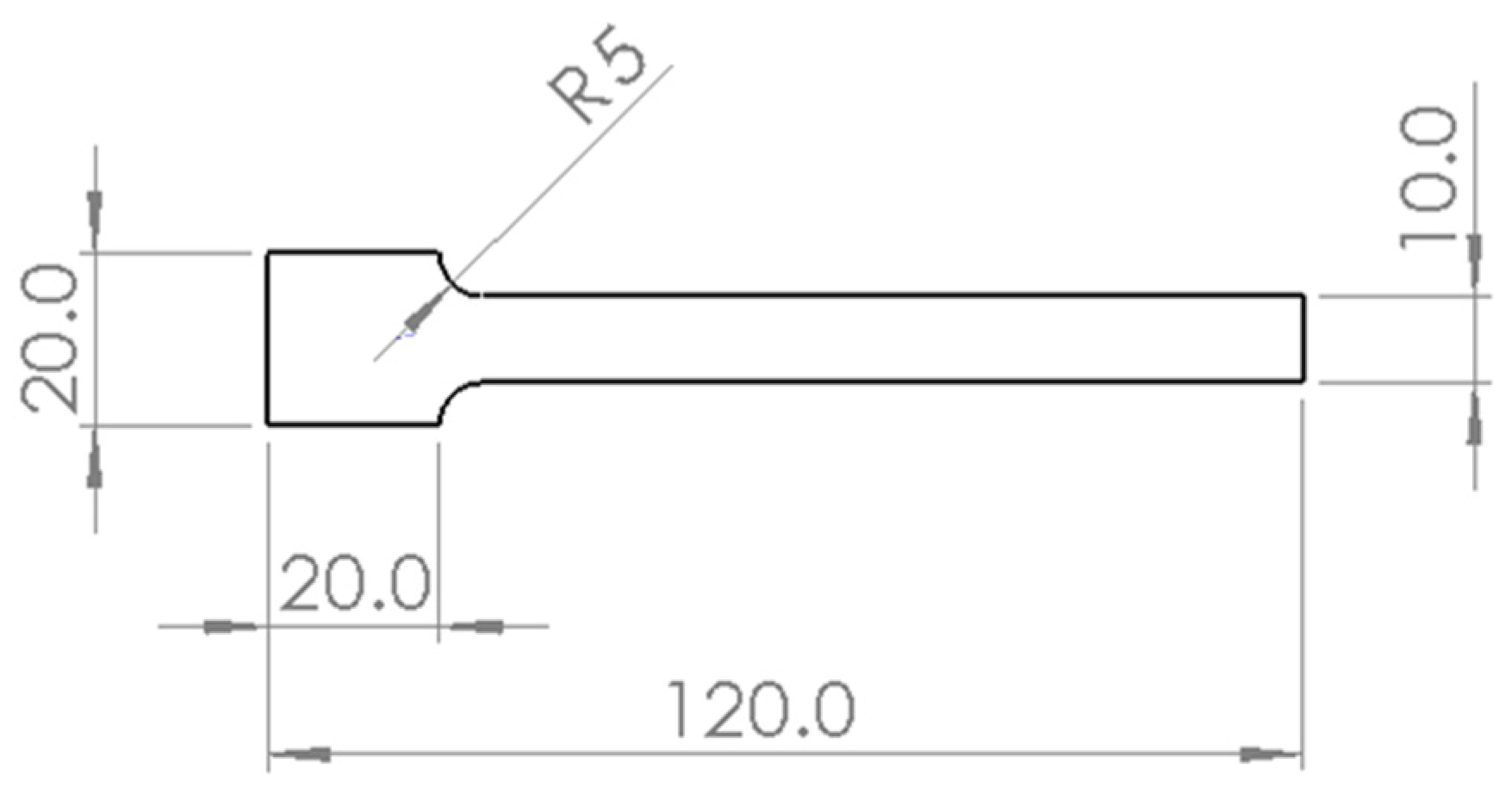



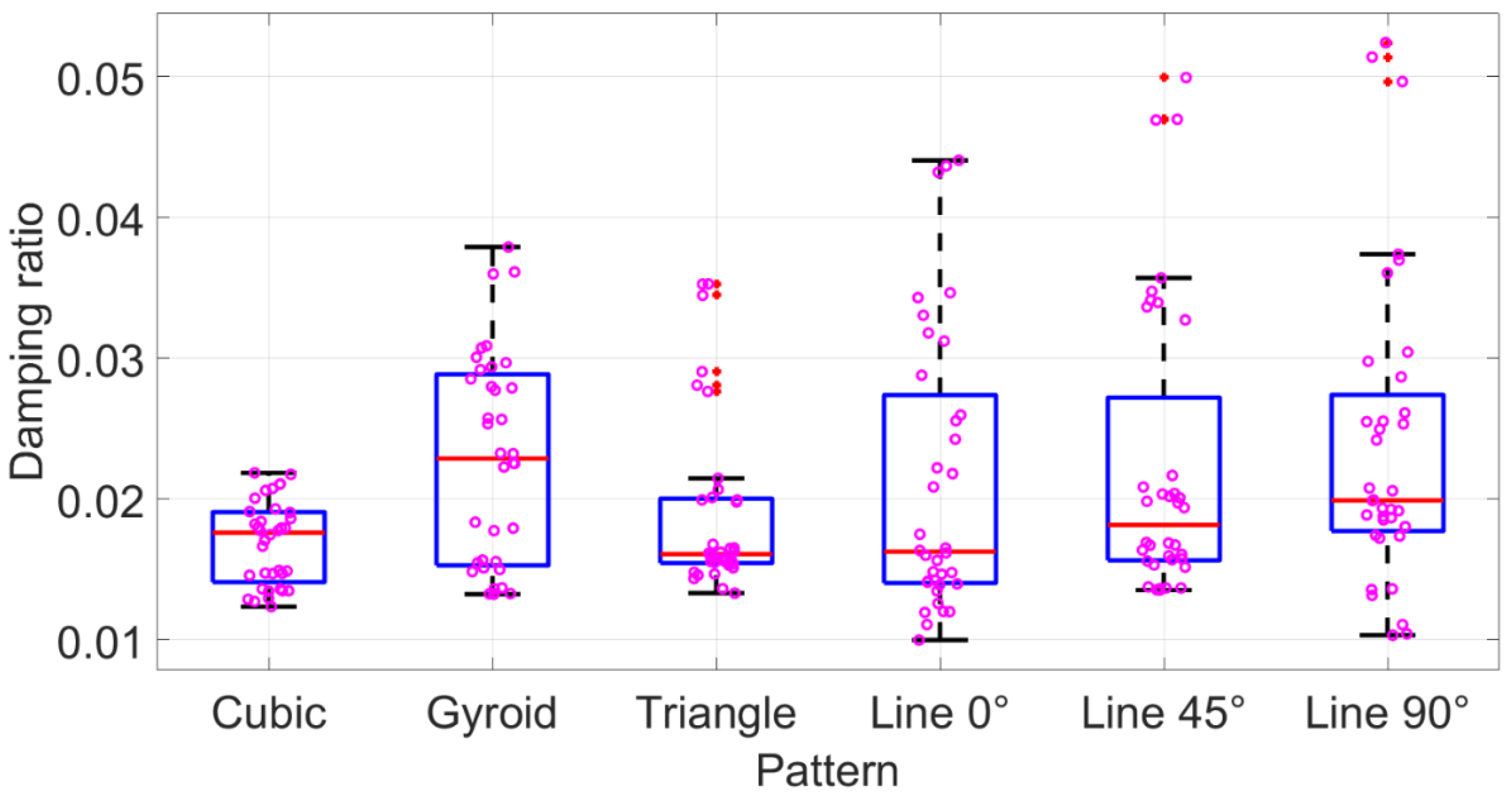


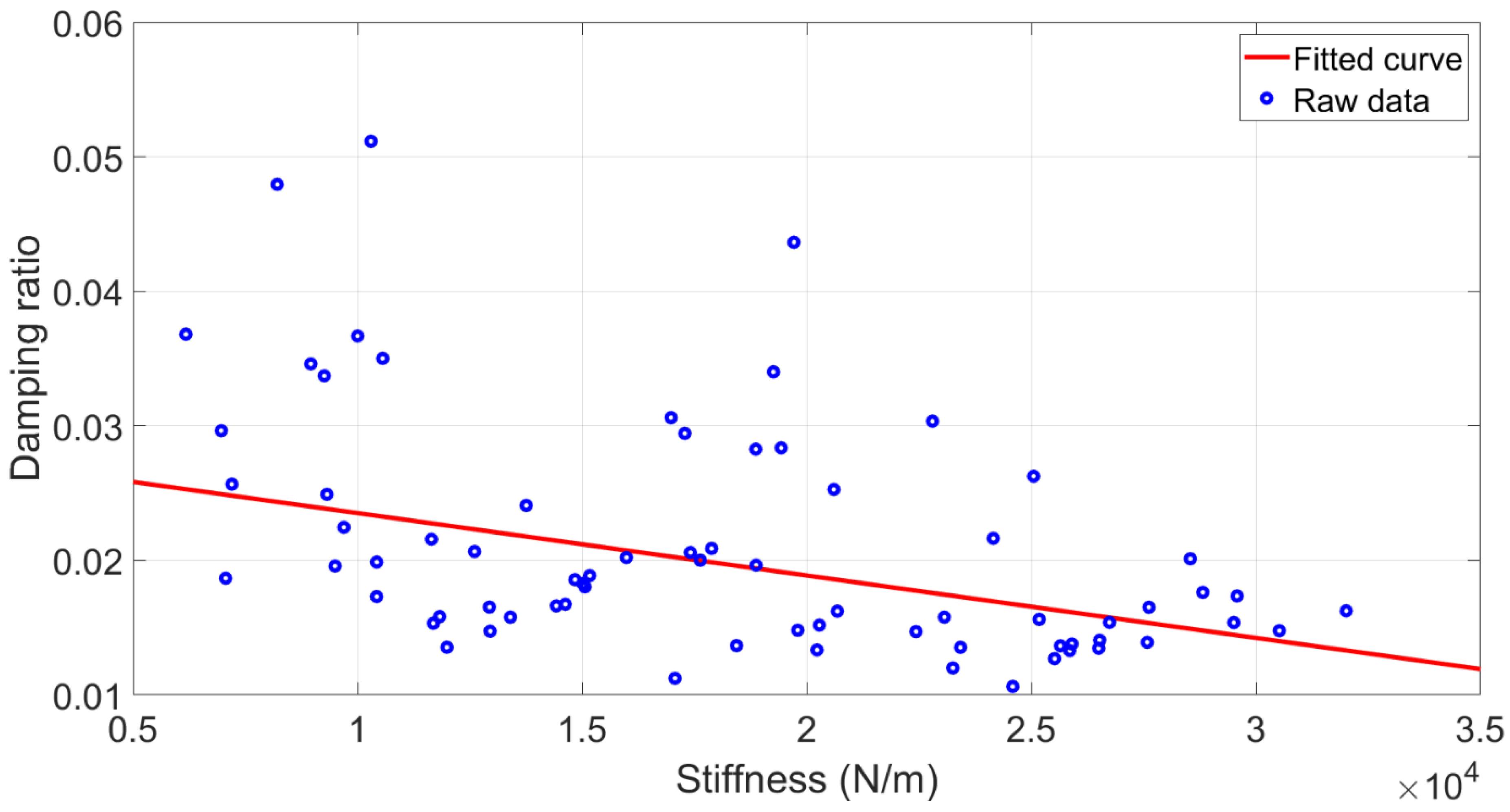
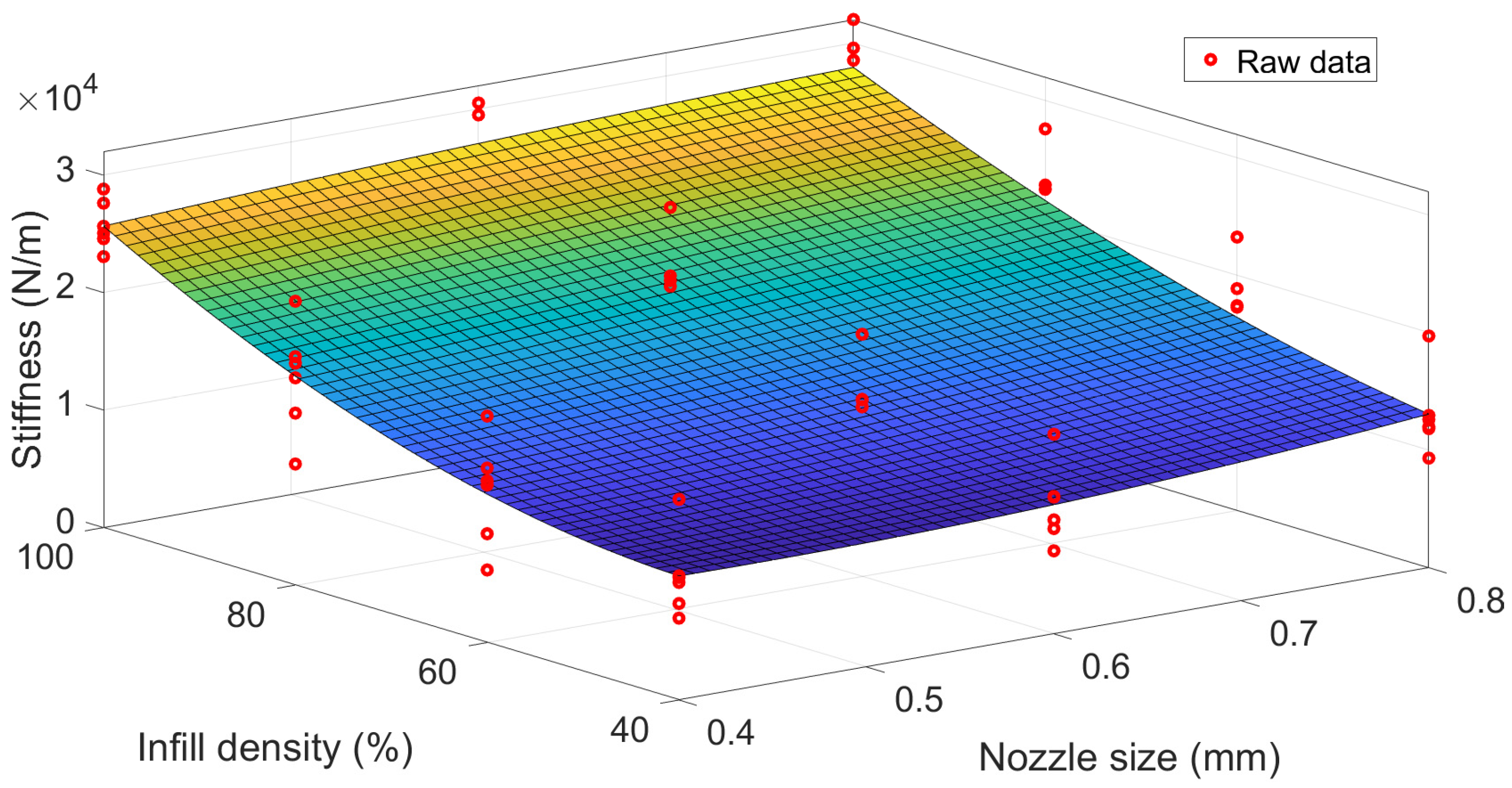
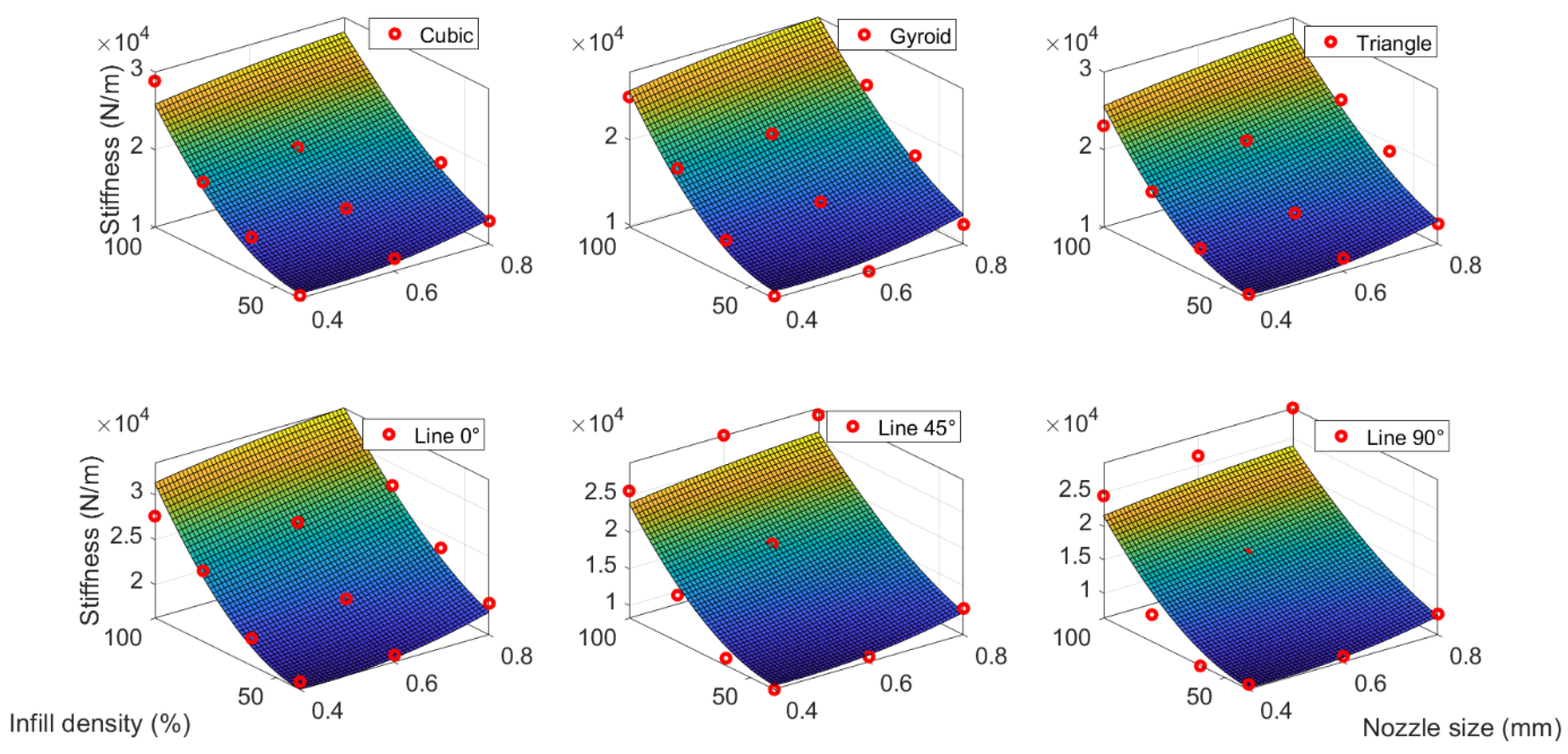
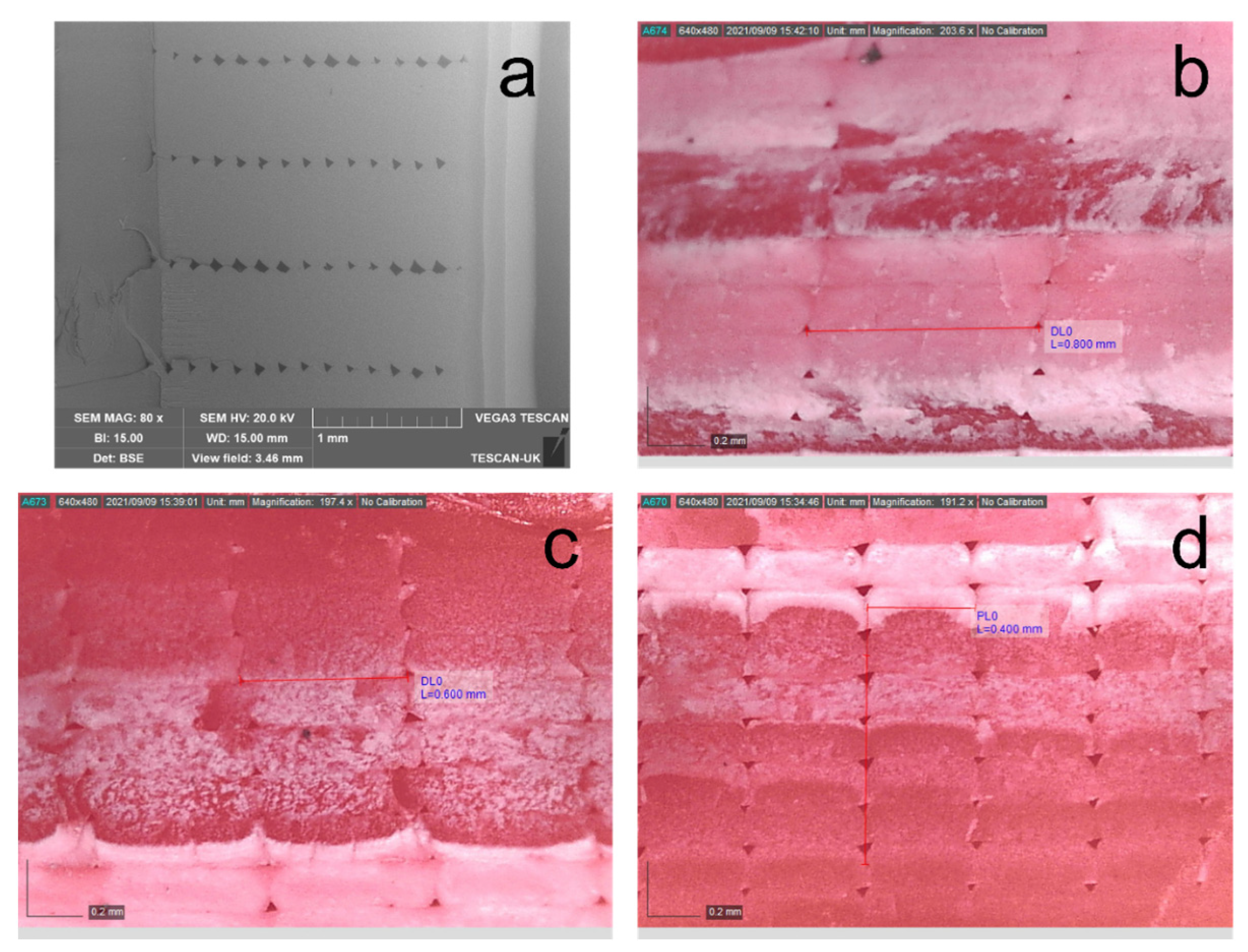

| Material | Ultimaker® ABS Red |
|---|---|
| Tensile modulus | 1618.5 MPa |
| Tensile stress at yield | 39 MPa |
| Tensile stress at break | 33.9 MPa |
| Flexural modulus | 2070 MPa |
| Flexural strength | 70.5 MPa |
| Melting temperature | 225–245 °C |
| 3D Printing Parameters | Nozzle Size (mm) | Infill Density (%) | ||||||||||
|---|---|---|---|---|---|---|---|---|---|---|---|---|
| 0.4 (n = 72) | 0.6 (n = 72) | 0.8 (n = 72) | 40 (n = 54) | 60 (n = 54) | 80 (n = 54) | 100 (n = 54) | ||||||
| Mean | 0.02495 | 0.01888 | 0.01817 | 0.025245 | 0.022951 | 0.020211 | 0.015674 | |||||
| p-value | 8.716 × 10−4 | 1.350 × 10−4 | ||||||||||
| 3D printing parameters | Infill pattern | |||||||||||
| Cubic (n = 36) | Gyroid (n = 36) | Triangle (n = 36) | Line 0° (n = 36) | Line 45° (n = 36) | Line 90° (n = 36) | |||||||
| Mean | 0.016893 | 0.022756 | 0.018983 | 0.021163 | 0.022411 | 0.023914 | ||||||
| p-value | 3.932 × 10−10 | |||||||||||
| Nozzle Size | Infill Density | Damping Ratio | |
|---|---|---|---|
| Nozzle size | 1 | ||
| Infill density | −3.60 × 10−17 | 1 | |
| Modal damping ratio | −0.26971 (p = 5.93 × 10−5) | −0.40612 (p = 5.52 × 10−10) | 1 |
| 3D Printing Parameters | Nozzle Size (mm) | Infill Density (%) | ||||||||||
|---|---|---|---|---|---|---|---|---|---|---|---|---|
| 0.4 (n = 24) | 0.6 (n = 24) | 0.8 (n = 24) | 40 (n = 18) | 60 (n = 18) | 80 (n = 18) | 100 (n = 18) | ||||||
| Mean | 0.0119 | 0.0118 | 0.0114 | 0.0118 | 0.0116 | 0.0118 | 0.0116 | |||||
| p-value | 0.0741 | 0.2208 | ||||||||||
| 3D printing parameters | Infill pattern | |||||||||||
| Cubic (n = 12) | Gyroid (n = 12) | Triangle (n = 12) | Line 0° (n = 12) | Line 45° (n = 12) | Line 90° (n = 12) | |||||||
| Mean | 0.0115 | 0.0114 | 0.0118 | 0.0118 | 0.0117 | 0.0120 | ||||||
| p-value | 0.0628 | |||||||||||
| Nozzle Size | Infill Density | Loss Factor | |
|---|---|---|---|
| Nozzle size | 1 | ||
| Infill density | −6.757 × 10−18 | 1 | |
| Loss factor | −0.2374 (p = 0.0446) | −0.0310 (p = 0.7960) | 1 |
| Regression Coefficient | Non-Standardised | Standardised | p Value |
|---|---|---|---|
| 0.050 | - | 5.274 × 10−13 | |
| −0.029 | −0.557 | 0.005 | |
| −0.000287 | −0.742 | 0.001 | |
| 0.000217 | 0.451 | 0.126 |
| Coefficients (with 95% Confidence Bounds) | Value |
|---|---|
| p00 (N/m) | 3.353 × 104 |
| p10 (N/m/mm) | −5.698 × 104 |
| p01 (N/m) | −733.7 |
| p20 (N/m/mm2) | 3.892 × 104 |
| p11 (N/m/mm) | 1136 |
| p02 (N/m) | 6.793 |
| p21 (N/m/mm2) | −459.3 |
| p12 (N/m/mm) | −4.251 |
| p03 (N/m) | −6.931 × 10−3 |
| Pattern | Value | R-Square Value |
|---|---|---|
| Cubic | 3.367 × 104 | 0.8899 |
| Gyroid | 3.359 × 104 | 0.9652 |
| Triangle | 3.346 × 104 | 0.9260 |
| Line 0° | 3.920 × 104 | 0.9012 |
| Line 45° | 3.178 × 104 | 0.9397 |
| Line 90° | 2.945 × 104 | 0.8848 |
| Study | Materials | Variable Parameters | Methods | Mechanical Properties |
|---|---|---|---|---|
| [11] | Polylactic acid (PLA) | Infill density | ASTM D638, ASTM D790, ASTM D256 | Tensile strength, flexural strength and impact energy |
| [12] | PLA | Infill density, infill pattern | ASTM D638, ASTM D570, ASTM D695 | Ultimate tensile strength, yield tensile strength, modulus of elasticity, elongation at break and toughness |
| [13] | Carbon fiber-reinforced PLA | Infill density, infill pattern | ASTM D638, ASTM D6110 | Tensile strength and impact strength |
| [14] | ABS | Infill density, infill pattern | ASTM D638 | Young’s modulus, yield strength and ultimate strength |
| [16] | PLA | Infill pattern | Compression test, fatigue test | Compression strength, fatigue strength |
| [17] | Polycarbonate (PC) | Infill pattern | ASTM D638, ASTM D5379 | Tensile modulus, tensile strength, flexural modulus, bending strength, shear modulus, shear strength, charpy absorbed energy |
| [18] | PLA | Infill density, infill pattern | ASTM D638, ASTM D256, ASTM D695 | Tensile strength, compression strength, impact strength |
| [20] | ABS | Nozzle size, infill pattern | Bending fatigue test | Fatigue life |
| [32] | thermoplastic polyurethanes (TPU) | Infill density, infill pattern | ISO 7743 | Specific energy absorption, specific damping capacity |
| [33] | PLA | Infill pattern | Impact test for cantilever beam | Modal damping ratios |
Disclaimer/Publisher’s Note: The statements, opinions and data contained in all publications are solely those of the individual author(s) and contributor(s) and not of MDPI and/or the editor(s). MDPI and/or the editor(s) disclaim responsibility for any injury to people or property resulting from any ideas, methods, instructions or products referred to in the content. |
© 2023 by the authors. Licensee MDPI, Basel, Switzerland. This article is an open access article distributed under the terms and conditions of the Creative Commons Attribution (CC BY) license (https://creativecommons.org/licenses/by/4.0/).
Share and Cite
He, F.; Ning, H.; Khan, M. Effect of 3D Printing Process Parameters on Damping Characteristic of Cantilever Beams Fabricated Using Material Extrusion. Polymers 2023, 15, 257. https://doi.org/10.3390/polym15020257
He F, Ning H, Khan M. Effect of 3D Printing Process Parameters on Damping Characteristic of Cantilever Beams Fabricated Using Material Extrusion. Polymers. 2023; 15(2):257. https://doi.org/10.3390/polym15020257
Chicago/Turabian StyleHe, Feiyang, Haoran Ning, and Muhammad Khan. 2023. "Effect of 3D Printing Process Parameters on Damping Characteristic of Cantilever Beams Fabricated Using Material Extrusion" Polymers 15, no. 2: 257. https://doi.org/10.3390/polym15020257
APA StyleHe, F., Ning, H., & Khan, M. (2023). Effect of 3D Printing Process Parameters on Damping Characteristic of Cantilever Beams Fabricated Using Material Extrusion. Polymers, 15(2), 257. https://doi.org/10.3390/polym15020257






